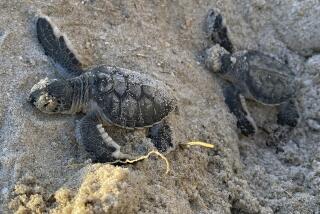Cluster of Islands Is Key Nesting Ground : Sea Turtles Gathering Off Australia
- Share via
Tens of thousands of giant sea turtles, obeying one of nature’s most powerful instincts, have been converging for several weeks on a cluster of tiny islands off the northern tip of Australia’s Great Barrier Reef.
Scientists say it is one of the largest mass gatherings of sea turtles ever documented, with thousands of the huge, migratory reptiles crawling ashore nightly to lay as many as 100 eggs each in the beach sand, and, as dawn approaches, returning to the sea.
The researchers estimate that between 50,000 and 150,000 turtles, known as green turtles, have joined the mass gathering. Many have come from feeding grounds as far as 1,500 miles away, returning to the same beaches on which they hatched decades earlier.
Main Nesting Ground
The Australian islands lie in waters about 3,000 feet deep, some 50 miles off the northern tip of the state of Queensland. They are believed to be the main nesting grounds, or rookery, of all the green turtles inhabiting the waters from Indonesia, to the west, to the Marshall Islands in the southwestern Pacific.
“There are always a few turtles coming to nest all year round and the numbers usually peak about this time,” said Colin Limpus, an Australian scientist who has been monitoring the phenomenon. “But last October the numbers started picking up every night. We go out there now and the beach is just turtle after turtle.”
On Raine Island, the largest at all of a mile in circumference, Limpus said he has counted as many as 11,500 turtles in a single night. The turtles weigh an average of 300 pounds each. Larger ones weigh as much as 400 pounds.
“That means there was about 1,700 ton of turtle step ashore that night alone,” Limpus said in telephone interview from his office at the Queensland National Park and Wildlife Service in Townsville.
Turtles Jammed on Beach
Limpus said that in walking about the rookery to make his nightly counts, there is sometimes no space between turtles and that it is necessary to walk on the backs of the jammed reptiles. Their shells average about 3 1/2 feet in length.
“There’s a lot of traffic but it’s actually pretty quiet,” Limpus said. “Each female is trying to find a nice, quiet place to dig her nest and sometimes they’ll wander around for hours looking for the right place. When they start digging, it looks like a dust storm--thousands of buckets of sand flying in all directions.”
The beach on Raine Island is about 100 yards wide and once the night’s turtles have come ashore, there are about six for every yard of waterline.
No one knows why there are so many turtles this year, but it is known that mass nestings recur. Limpus, an internationally recognized biologist who has been studying Australia’s sea turtles, recalled a similar phenomenon on the same islands 10 years ago. He suspects climatic changes in the ocean trigger the phenomenon and is searching for evidence of this.
Sea turtle experts in the United States were astonished on hearing how many animals were showing up on Raine Island.
“That’s just incredible,” said Archie Carr of the University of Florida at Gainesville, widely considered the leading sea-turtle researcher in the United States. “We’ve seen large concentrations of other species at times in the Caribbean, but not this big.”
Species Severely Depleted
Carr said green turtles were severely depleted in Caribbean waters. About 30 or 40 show up each year on Florida beaches. Far more plentiful are such other species as loggerheads and olive-Ridley. Some 60,000 olive-colored Ridleys have been known to turn up on Caribbean beaches.
Christopher Columbus reported seeing vast concentrations of green turtles when he landed on Grand Cayman Island in the Bahamas. “What we’re seeing on Raine Island is probably what Columbus saw,” Limpus said. “There hasn’t been a green turtle on Grand Cayman in 80 years. They’ve all been hunted out for the meat.”
Limpus said although the Raine Island population is one of the last remaining large concentrations, hunting is catching up with it, too. In 1983, statistics show, 36,000 green turtles were killed in Indonesia for food and for the shells. Thousands more were taken in other parts of the animal’s range.
“They’re fully protected in Australia,” Limpus said, “but they only spend a small part of their lives here. Most of the time they’re far away on the feeding grounds. That’s where they’re catching them. The harvest is immense. Some of the turtles that nest here this year will be feeding tourists in Bali next year, or villagers in New Guinea.”
Eggs Vulnerable to Fish
The life cycle of the green turtle remains largely a mystery. Seven or eight weeks after the eggs are laid in the sand and buried, the hatchlings emerge and claw their way up to the surface. They scurry to the water but predatory birds pick off large numbers. In the water, they are vulnerable to carnivorous fish. Limpus estimates that only about one or two per thousand hatchlings live to maturity.
During their decades of maturation, the turtles travel many hundreds of miles from their native beach, feeding on seaweed in the shallower waters near islands and continents. Then, when sexual maturity develops and the mating season arrives, the animals begin swimming back to the beach they left decades earlier.
Mating takes place along the way and the males return to the feeding grounds. The females continue on to the rookery.
More to Read
Sign up for Essential California
The most important California stories and recommendations in your inbox every morning.
You may occasionally receive promotional content from the Los Angeles Times.












